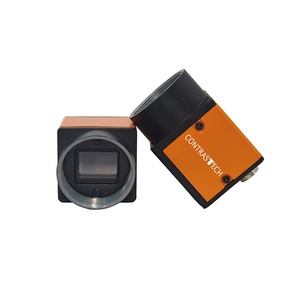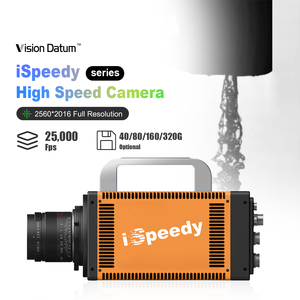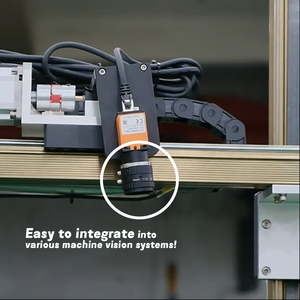(106 products available)










































































































































































































































There are various types of high-speed cameras that support 1000 fps (frames per second), suitable for specific applications. Below are the most commonly used types for macro photography.
These cameras employ a Charge-Coupled Device (CCD) sensor to capture rapid-motion videos. These cameras are ideal for motion analysis as they provide high-resolution images with minimal noise, making them suitable for precise experiments in fields like physics and engineering.
CMOS (Complementary Metal-Oxide-Semiconductor) cameras have become popular because of their fast-readout speeds and lower power consumption. They are widely used in industrial applications, high-speed filming, and scientific research due to their versatility and cost-effectiveness.
These cameras are designed to eliminate motion distortion by capturing all pixels simultaneously with a global shutter. This feature makes them ideal for capturing fast-moving objects without blur, which is essential in areas like ballistic testing and high-speed sports analysis.
Simple slow-motion cameras can shoot 1000 fps, and some can even go up to 10000 fps. These affordable options capture slow-motion footage, mainly used in the film industry for artistic purposes. Although not as advanced technically, they are accessible for capturing high-speed events like explosions, athletic moves, and any rapid motion in action sequences.
These are often used in research or industrial settings where specific frame rates, resolution, or lighting conditions are needed. For instance, some models are optimized for capturing chemical reactions or combustion, providing unique insights into processes invisible to the naked eye.
High-speed cameras capable of 1000 fps are valuable in many industries. Here are the most common applications for these versatile cameras.
These cameras record athletes' performances at high speeds, allowing coaches and trainers to break down techniques frame by frame. In fast-paced games like football, basketball, or any racquet game, studying movements can improve training methods, injury prevention, and gameplay strategies.
In manufacturing, these cameras monitor machinery and production processes. Capturing high-speed sequences of machine operation helps engineers identify any inefficiency, potential breakdowns, or defects in the production line that might go unnoticed at regular speeds. This reduces downtime by allowing preventive maintenance to be carried out in time.
These cameras are used to study the trajectories of projectiles, gunfire, and explosions in military and defense research. Understanding the dynamics of high-speed events enables better designs of weapons and ammunition while improving safety protocols. The detailed slow-motion analyses help in enhancing predictive models that are later used in simulations.
Researchers in fields such as physics, chemistry, and biomechanics use these cameras to capture and analyze fast phenomena like chemical reactions, fluid dynamics, and the motion of small insects. By providing detailed visual data, these cameras help advance understanding in many areas, from materials science to biological studies.
In medicine, they capture physiological processes like heartbeats, muscle movements, and more. High frame rates allow detailed analysis of rapid biological functions that help in the development of better diagnostic tools, treatment methods, and understanding of diseases related to the nervous and muscular systems.
They are used to test product durability and safety features such as seat belts, airbags, and protective gear under extreme conditions. Capturing high-speed impacts and stress tests in slow motion allows engineers to analyze their performance and ensure they meet safety standards before putting them out in the market.
High-speed cameras are essential tools for capturing events at a much higher frame rate than regular cameras. Their technical specifications determine how effectively they can be used in various viewing applications.
Of course, the key feature is that it can shoot up to 1000 frames per second. However, some high-speed cameras can go even further, up to 10000 fps. Also, many of them maintain high resolutions, from 720p to 1080p, even at high frame rates. These two functions give the camera the ability to capture smooth, detailed slow-motion video of fast-moving subjects.
Apart from normal high frame rates, some cameras feature burst shooting. This function allows the camera to take a series of shots at extremely high frame rates, such as 1000 fps, for very short periods. This is especially useful in critical situations where a split-second action needs to be captured.
These cameras have fast shutter speeds, usually with a short exposure time of 1/1000 to 1/8000 seconds. Fast shutter speeds enable the camera to reduce motion blur when recording fast-moving objects by ensuring each frame captures a clear, sharp image.
Most of them have high-sensitivity sensors, which makes it possible to shoot in low-light conditions. Such a feature allows the capture of high-speed events under different lighting circumstances.
That high frame rate means large amounts of data will be generated, meaning these cameras must come with either internal memory or external storage solutions. Common storage formats include SD cards or high-speed SSDs, generally providing several gigabytes of memories to hold extended video sequences at high resolutions and frame rates.
High-speed cameras use two main types of sensors: Charge-Coupled Device (CCD) and Complementary Metal-Oxide-Semiconductor (CMOS). CCD sensors generally offer higher image quality and are more sensitive to light, ideal for low-light conditions. In contrast, CMOS sensors are faster and cheaper to manufacture, providing more versatility in various applications.
It can also shoot in slow motion, which is useful in film and sports to analyze moving actions. Some can even hit incredible slow-motion rates, such as 1000/1 for breathtaking ultra-motion sequences.
To make it durable and reliable, one has to ensure its quality and maintenance. These cameras, capable of 1000 fps, require proper care to retain their performance in several demanding environments.
They are built with high-quality materials as they are exposed to demanding conditions such as heavy impacts, vibrations, and extreme temperatures. Most of these cameras have shock-resistant housings and rugged designs to protect internal components and sensors, especially during ballistics tests or in industrial machinery monitoring.
In addition to being durable, many of these high-speed cameras are also waterproof and dustproof, making them suitable for outdoor use where environmental hazards are likely to occur. Such ratings as IP67 or IP68 indicate that the camera can withstand water immersion and dust exposure. This ensures functionality while shooting in adverse weather.
Most cameras come with good heat resistance, which is critical in the applications where they may be exposed to intense heat, such as in explosion recordings or during scientific tests involving combustion. Many of them are designed to operate effectively even under high temperatures, with heat-dissipating casements or internal cooling systems.
The battery life of high-speed cameras can endure long shootings. Many such cameras have high-capacity batteries specifically designed for long operational hours without interruption. Some models have replaceable batteries, allowing users to switch out fresh ones during shoots quickly, while others support external power sources for extended use.
Some of them come with easy servicing, allowing users or technicians to access internal components for repair or servicing quickly. Modular designs with easily removable parts like sensors, fans, or circuit boards can make maintenance more accessible and less time-consuming, especially during intensive fieldwork where the camera needs frequent servicing to keep it functional.
The cameras can withstand industrial-grade lenses that will be frequently changed in various applications. These lenses are designed to bear shocks and are large enough to cover the moving objects in an industrial setup. Also, the lens mount area is designed so that it can be replaced easily without damaging the internal components.
It is crucial to protect these high-speed cameras from physical impacts, exposure to dust, and any other potential threats. Withstanding high frame rates, they would generate considerable amounts of heat; consequently, the internal components must be cleaned and checked frequently to avoid overheating and ensure the device functions optimally. The battery should be checked regularly, while software and firmware should be updated to include new features and optimizations while protecting the system. Whenever the situation calls for it, troubleshooting common problems such as failure to record, failure to power up, and many more should be addressed.
Shooting at high frame rates allows for ultra-slow action. What appears to be rapid motion is captured in minute detail, making it possible to analyze the action scientifically. This capability benefits productions by providing visually stunning effects for filmmakers while improving the functional understanding of dynamic actions in various industries.
Certainly. Many of these cameras come with high-sensitivity sensors that allow effective operation in low-light conditions. They also benefit from industrial lighting in Most of the industrial applications where bright lighting is usually used.
Some issues include overheating during extended use, difficulty storing large amounts of data at high frame rates, and motion blur if the shutter speed is slow. These problems can be fixed by using external storage drives, employing effective cooling methods, and ensuring fast shutter speeds and good illumination for the shots.
If ordinary cameras can be used, then any action will appear vague. Ordinary cameras are good for regular activities like taking pictures, but when it comes to peculiar activities, high-speed cameras are needed for clarity and detailed analysis.
They usually provide high-speed playback options that require specialized software or hardware because of the high frame rates. Mostly, they can be recorded at lower frame rates for standard playback to permit conventional video editing and analysis.